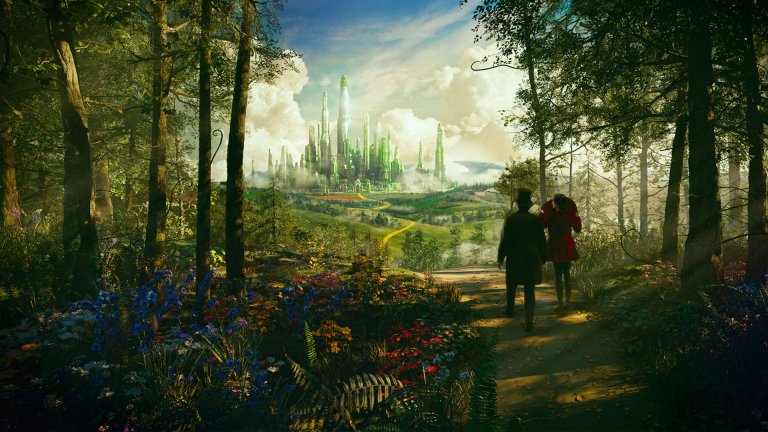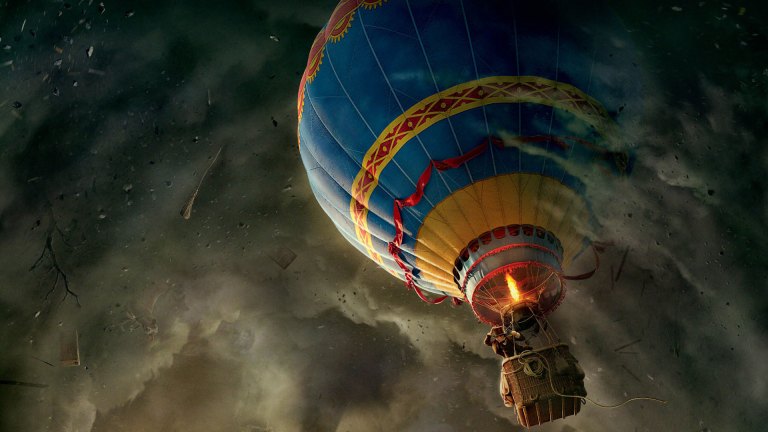Pay no attention to the man behind the curtain
ALL IMAGES IN THIS ARTICLE CREDITED TO: DISNEY/MOVIE LENS

By the time that Disney got around to tackling the world of Oz again on a cinema screen it was over twenty five years since the financially disastrous but artistically sound experiment that was 1985’s Return to Oz. This new film would not be based on any of L. Frank Baum’s original books, instead it would be a new tale, set before all of Baum’s classic works. The film, Disney decided, would be a prequel.
Oz the Great and Powerful is the story of the Wizard of Oz and his arrival in that familiar magical land after being whisked away by a tornado in a hot air balloon as a young man. The Wizard (James Franco) is a charlatan, a con-man who preys on the trust and naiveté of those around him and in that way scratches out the basest of livings in a travelling circus that roams the Kansas prairies. His arrival in the bright and vibrant world of Oz offers him new opportunities to cheat and a whole new civilisation of rubes to part from their money. You see, there is a prophecy, as Theodora the witch (Mila Kunis), the first person the Wizard meets upon his arrival, so helpfully informs us. The King of Oz has died, murdered by his witch daughter (Michelle Williams) but before he slipped away into that good night, he made a prophecy that one day a Wizard would arrive in the land, vanquish the wicked witch and be rewarded with the throne. The Wizard sees dollar signs.
I’m not generally one of those people that gets really upset with the alteration of established canon in long-running series and if you’d asked me before I watched Oz the Great and Powerful I doubt I’d have said I was invested enough in the lore of the Oz stories to care much one way or the other. I’d have been wrong though. Oz the Great and Powerful makes some character choices with established figures in the Oz universe that I really, really, didn’t care for. It plays fast and loose with the mythology of the world that it depicts and the iconic characters that it features and in doing so it comes frighteningly close to losing the spirit of the stories that inspired it. Too much of the film feels like a studio note, an imposition upon the story that comes off as a decision made because it fits into some pre-established formula for modern day blockbusters rather than one made for it’s artistic merit.

Perhaps a greater problem than this however is the horrible miscasting of the film’s leads. Franco and Kunis are entirely out of their depth; Franco works as a very specific type of character and the Wizard of Oz is not it. The bluster and bravado of the character only works if the actor sells it, if the performer is charismatic enough to sell the con to the audience as well as the characters within the film itself. It’s an essential requirement for the role and Franco can’t pull it off. His Wizard’s grand claims and theatrical showmanship are so transparently false that the concept of the character as some master manipulator rings hollow from minute one and it hurts the movie badly. Robert Downey Jr was apparently offered the role but turned it down due to disinterest. Johnny Depp was another contender, but was already signed on to The Lone Ranger and so was forced to decline due to scheduling conflicts. Either of these actors would have made a far more effective lead than Franco; both could have sold the unreal as real in a way that Franco couldn’t. Either one of them would have made for an immediately better movie but the problem of unreality persists far beyond the character of the Wizard. Kunis is an actor with broader range but, just like her co-star she’s asked to step into a role entirely unsuited for her. The character arc of Theodora is an extreme one, one that tilts towards challenging moments that require a great deal of authority to sell. Kunis doesn’t have that power here, at least she doesn’t have the ability to sell such an extreme character transition. Perhaps if she’d been asked to play one end of the spectrum or the other by itself she’d have been more successful but in the effort to fuse those extremes together both become wholly unsatisfying.
If the film’s characters fail to come off as real, the film’s setting makes that same failure ten times over. Director Sam Raimi (doing his worst work in years, even the maligned third instalment of his Spider-Man trilogy has a more genuine directorial vision than this) insisted on the construction of real sets to be augmented by CGI backgrounds but he really needn’t have bothered: it looks drenched in computer effects regardless. The original 1939 Wizard of Oz was hardly a masterclass in life-like environments (it was all shot on a soundstage) but it was at least all done in camera. It was there, a physical presence on the set and so a physical presence on the screen. For all it’s hokey cardboard backdrops and painted skylines it felt like a living and breathing place, one that the actors were interacting with. Oz the Great and Powerful on the other hand is an artificial creation, comprised of pixels and polygons and all the small parcels of sets built for the foreground of the scenes can’t restore the life that the digital sheen has sucked out. It certainly doesn’t help that Raimi seems to have gotten very socially excited at the prospect of making a 3D movie; that fad, which was already being done more out of habit than public interest by the time 2013 rolled around, is an overwhelming influence on his directorial choices. Raimi throws random stuff at the screen as often as he can and shoehorns in numerous oddly framed shots for the clear purpose of justifying the 3D version that the vast majority of the film’s audience was never going to see, especially once the film had left cinemas. These moments are cheesy asides that feel like the kind of thing that audiences would have seen in some long forgotten B-movie about giant ants in the 1950s, a relic from 3D’s last go at the bat when viewers were handed flimsy cardboard glasses with a blue and red lens as they entered the theatre. These obvious flourishes only add to the film’s businesslike veneer, the overwhelming suggestion that every decision made was in service of a corporate agenda rather than an artistic one.
For all these problems, the film does have it’s charms however. A talented supporting cast featuring Williams, Rachel Weisz, Joey King and Zach Braff are a far better fit for their characters than the leads are. King and Braff in particular are stand-outs: both are playing CGI characters and both are able to imbue them with life and personality in a way that defies the soulless artificiality that has consumed the rest of the film’s digital effects work. Equally, the quality of the craftsmanship on display in the film’s physical sets are of a level worth admiration and the way in which CGI characters interact with human ones bears a technical prowess lacking in those same human characters involvement with the digital backgrounds.

Oz the Great and Powerful made a lot of money and though Disney quickly announced a sequel following the film’s release, nothing has been heard of it since. Perhaps they thought better. Oz the Great and Powerful is a graceless mixture of artificial banality, poor star performances from actors who can do better and a script that is all too willing to defy it’s source material. Blended together by the suffocating air of corporate interference, this witch’s brew is a bitter one and though it has a few lonely bright spots, it remains an unappetising final product.
